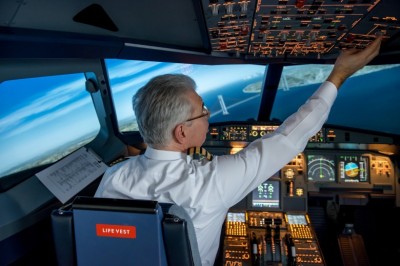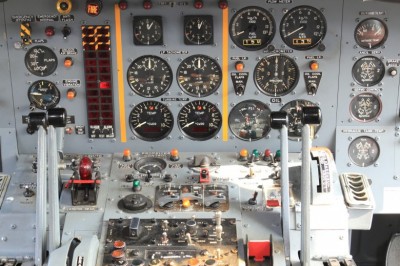The Five Essential Techniques for Instrument Flight Training
A heavy pilot workload makes instrument flying hard. This article shows you, the pilot, how to reduce your cockpit workload and greatly simplify instrument flying. The truly positive side effect is you will fly more precisely and make fewer mistakes. Any student pilot knows that the most important instrument is outside of the airplane. It is the horizon. When you fly into a cloud the horizon disappears. But the airplane continues to fly just as it did outside of the cloud. This tells you that you should fly the airplane on instruments just as you did visually but somehow you must compensate for the lost horizon. On instruments you do exactly the same thing you do visually except you use the attitude indicator (a.k.a. artificial horizon) rather than the real horizon to stay aware of the aircrafts attitude. All flying is an iterative process. You fly by changing some parameter, maintaining a constant attitude, letting the airplane return to a steady-state condition, monitoring the flight instruments, adjusting a parameter, maintaining a constant attitude, letting the airplane return to a steady-state condition,... The parameters that you change may be attitude, power, a primary flight control, flaps, etc. The ONLY difference is that attitude must be consciously monitored because your peripheral vision cannot monitor attitude for you. Since attitude must be monitored in a way that is neither intuitive nor as easy as visual flying, you need a disciplined scan for instrument flying. By scan I mean how you look at instruments, which instruments and in what order. Beyond question, the attitude indicator is the most useful instrument. Ironically, it is not an essential instrument nor is it the primary instrument in many situations. It is most useful because it substantially reduces the workload of instrument flying. The attitude indicator should be the pivot point of your scan. For example, in straight and level flight... Let me interrupt myself right now and ask you what you think the primary instruments are during straight and level flight? By primary instruments, I mean the must have instruments. Which instrument absolutely, positively tells you that your pitch attitude is correct? Which instrument tells you that your bank is correct? Which instrument tells you that your rudder is in the proper position? Dont read the next paragraph until you give yourself the answers to these questions. Here come the surprising answers. The altimeter is primary for pitch, the gyrocompass is primary for bank and the ball is primary for rudder. To illustrate the point about primary instruments, assume that you are flying an airplane with its wing-leveler engaged. You have been assigned an altitude of 8,000 feet. For the purpose of this discussion, all you need do is get the pitch attitude right. Looking at the attitude indicator, everything looks correct. The little airplane is exactly on the horizon. Does that tell you that you have the pitch attitude right? You dont know. You have to look at the altimeter. Look at it long enough to answer two questions: What does it say? What is it doing? If it reads 7,960 feet and is moving up slowly, it tells you that your pitch attitude is too high! If the altimeter reads 7,960 feet and is not moving, congratulations, your pitch attitude is perfect. Your altitude tells you nothing at all about pitch attitude. Your scan includes the attitude indicator and primary instruments. The movement of any primary instrument provides feedback about your attitude. If the gyrocompass were moving it would tell you that youre turning. If youre turning and the ball is in the center, then your wings are not level. You need to look at the attitude indicator long enough to level your wings. Continue to scan. You may ask, "Why not the rate-of-turn indicator?" The reason is that monitoring the rate-of-turn adds to your workload; you need to check your heading; and the gyrocompass gives you the turning information you need. In straight and level flight without any artificial stabilization, your scan might follow this sequence: attitude indicator, altimeter, attitude indicator, gyrocompass, repeating for perhaps two or three cycles. A quick glance at the ball followed with a compensating rudder trim would suffice, then ignore the rudder trim. You need to determine which instruments are primary in every region of flight or you will not always be able to decide on the correct scan. For example, when you are climbing, your airspeed indicator is your primary pitch instrument and gyrocompass is primary bank. When you are in a level standard rate turn, your rate of turn is primary bank and altimeter is primary pitch. When you are in a 30 bank, the attitude indicator is primary bank and altimeter is the primary pitch instrument, etc. Adjust your scan for every situation. By now you are thinking that you have other instruments to worry about than those I mentioned in your scan. Youre right. Remember that your most important cockpit task is to fly the airplane. Once that is unquestionably under control then you can start adding other items to every third or fourth scan. Also remember that during an instrument approach, an ILS or VOR could easily become one of your primary instruments. So the fundamental principles that you need to understand and apply to your instrument flying are: 1. Notice both an instruments reading and movement. 2. Use an instruments movement to provide feedback about your current attitude. 3. Look at the attitude indicator when adjusting attitude. 4. Use the attitude indicator as the base of your instrument scan, moving your focus from attitude indicator to primary instrument, to attitude indicator to some other primary instrument, etc. 5. Modify the collection of primary instruments included in your scan as the region of flight changes; dropping some from your scan, adding others. ------ Doug Daniel is a long time pilot, flight instructor, software engineering manager and author. His department developed the software for the out-the-window-displays for the space shuttle, F-117, RS-71 and numerous other exotic airplanes. His writing focuses on flying techniques designed to make flying easier and safer. If this was interesting, visit his website at http://www.FlyingSecretsRevealed.com/flying_questions/
























